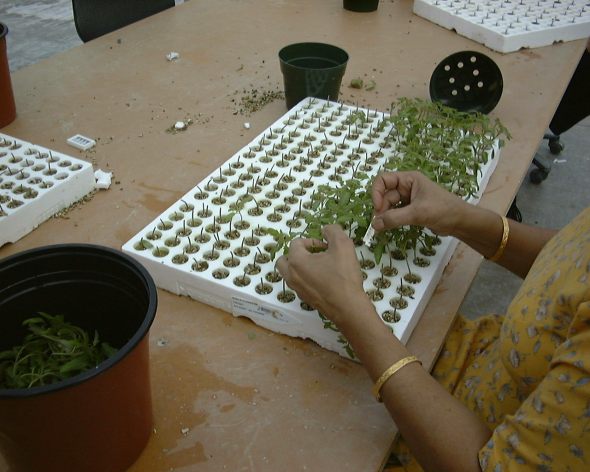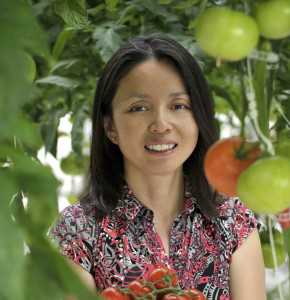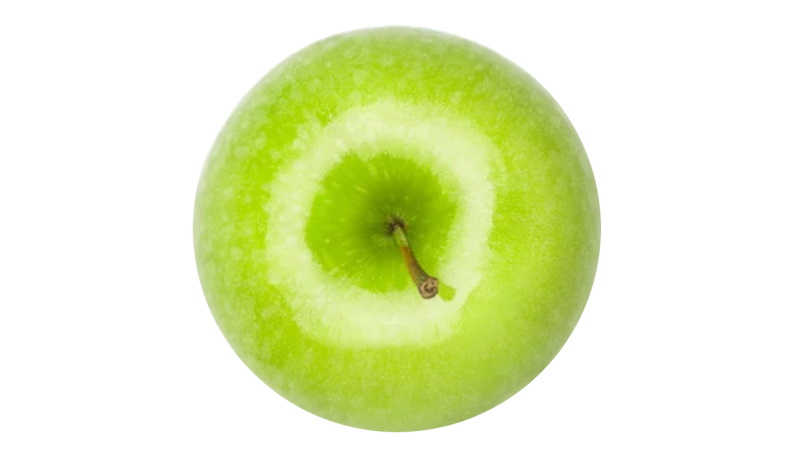How To Be Successful Using Grafted Vegetable Plants
Who wouldn’t want healthier vegetable plants that have a better chance of resisting disease pressure? That is just one of the benefits of grafting that Chieri Kubota, a professor in the School of Plant Sciences at the University of Arizona, will demonstrate at the upcoming Spring Short Course — Greenhouse Crop Production and Engineering Design.
The University of Arizona’s spring 2015 Greenhouse Crop Production & Engineering Design Short Course will be held March 22 to 27 at the Controlled Environment Agriculture Center (CEAC) in Tucson, AZ. (Click here for more details on the short course.)
American Vegetable Grower caught up with Kubota to find out about the latest developments in grafting, its benefits to growers, and the pitfalls to avoid when adopting the technology.
How is grafting enhancing greenhouse vegetable production?
Kubota: We know yield increase is the major advantage of using grafted plants for greenhouse tomatoes. In the short course, we are highlighting soilless hydroponic production of tomatoes because in soilless production, the purpose of grafting tomatoes is not for disease resistance but for yield increase. The typical increase in yield [in the greenhouse] is 10% to 15%. Because of the high yields of tomato crops, this 10% to 15% increase easily pays for the cost of grafting.
What advice can you offer growers looking to use grafted plants or do their own grafting?
Kubota: My advice is to try commercially grafted plants first before deciding whether to continuously buy plants from grafting nurseries or graft yourself. I recommend growers buy commercially grafted plants first because the quality of the graft affects the performance. For growers grafting for the first time, the result could be affected by the skill level of the grower doing the grafting. If it is a few thousand plants to graft, a grower can easily do that by himself by using one or two well-trained people to help. But try the high quality, commercially grafted ones first, and then decide if grafting on your own makes sense based on the number [of plants] you will need.
What are three things growers need to remember to be successful?
Kubota:
- Design and build the correct healing system. Growers who want to graft their own plants must design a good healing system because that is the most important stage of grafting propagation. Many growers fail because the healing system was improperly designed. The healing system serves the same function as the intensive-care unit in the hospital.
- Propagate scion and rootstock seedlings to have matching size. Planning the seeding time and growing period conditions are very important. If the scion is larger than the rootstock or vice versa that will reduce the success rate of the graft.
- Select a good rootstock that works well with the scion variety. Seed companies can help or academic researchers working in grafting can suggest which rootstock to use.
What are some of the pitfalls greenhouse vegetable growers need to avoid when implementing this technology?
Kubota:
- Choose rootstocks wisely. One thing growers need to know when they are growing heirloom varieties is to be careful in the selection of the rootstock. Heirloom tomato varieties have specific rootstock compatibility issues. As a result, growers need to consult with researchers on rootstocks. Heirloom varieties do not have resistance to tomato mosaic virus and plants can be killed instantly when specific rootstocks are used and later infected by the virus in the greenhouse. This is not new information, but in North America, old heirloom varieties are being grafted on modern rootstocks and that is creating a unique situation in the U.S.
- Withhold watering rootstocks before grafting. Too much water before grafting on rootstock sometimes reduces the success rate of the graft. Roots can push water to the cut end of the rootstock, which pushes back the scion and creates loose contact between the two tissues, reducing the success rate of the graft.
- Manage fertilizer applications to avoid excessive vegetative growth early on. Strong rootstock tends to make the scion very vigorous and vegetative during the first one or two truss production. At the early stage of production, growers may need to reduce the nitrogen to balance the growth.
What have been the drawbacks to more widespread adoption of the technology by greenhouse producers?
Kubota:
- Availability of grafted plants. We don’t have sizeable grafting companies in the U.S., although one nursery is scheduled to be operational in North Carolina in 2016, so we are hopeful to improve the situation in the near future.
- Cost for small-scale grow Right now, small-scale producers have to pay more than $1 per plant, plus the seed cost. That is pretty expensive. If the grower has many acres, then the price gets lower because of the increase in volume. The seed price doesn’t change much but the plant price does based on the volume of the order.
What do you think it will take to have more growers using grafted plants?

Chieri Kubota of the University of Arizona says to successfully graft plants, design and build the correct healing system.
Photo credit: Chieri Kubota
Kubota: The availability of plants will need to increase and costs must be reduced, and not just reducing the cost of the plants but reducing the cost of rootstocks seeds. Some of the rootstocks, to me, are too expensive. Right now the market for rootstocks in the U.S. is small, so as the market grows I will expect the price to go down.
Some of your recent research involved improving propagation technology for grafting while making grafted seedlings available nationwide. Have you begun testing to evaluate the impact of new technology, such as automation, in the grafting process?
Kubota: In my program, we haven’t actually tested automation, but we did a simulation of cost. The simulation included manual grafting versus automation and it appears automation could reduce the cost very significantly: about 22% reduction for tomato plants and 54% reduction for watermelon. That is our estimate based on simulation by introducing automation and scaling up production. You can’t introduce automation for small-scale propagation; you have to have a certain size to make automation worthwhile.
We haven’t figured out the threshold for size yet, but we did a comparison between a medium-size grafter which is 1 million grafts per year with manual grafting, and a large producer which is 100,000, 000 grafts per year with fully automated grafting. The above-mentioned cost reductions were based on this comparison. We published this cost analysis in a journal (HortScience) last year.
Another technology we evaluated in my program is low-temperature storage. We evaluated for adjusting the propagation schedule or distributing labor input over time rather than concentrating in the limited production window. That technology seems to be very reliable but hasn’t been introduced in a commercial situation yet.
The idea is to grow scions and rootstocks and put them into a low-temperature storage chamber for a week or two weeks to adjust the schedule so you can start grafting earlier than normal schedule, This allows producers to distribute the labor input over time. The technique might work for small growers allowing them to can work with just two people and graft little bit by little bit over several days and then store the plants.
I haven’t introduced low-temperature storage to any commercial nurseries yet. Our group tested different conditions, and short-term storage is not a problem as long as the temperature and light intensity are well selected for the specific combination of scion and rootstock.
Where do you see this technology headed in the future?
Kubota: In addition to tomatoes, I think more crops are going to be grafted, including: cucumber, melon, eggplant, and pepper. These crops have been grafted in other countries, but in the U.S., greenhouse tomato is the only crop grafted. For open fields, we know that some watermelon growers started using grafted plants.
We will begin to see grafting of those crops because they are also grown in greenhouses and high tunnels. Soil-borne disease can be an issue in high tunnels and grafting is the only way to reduce soil-borne disease if there is no other means to sterilize the soil.
What will your grafting presentation at the short course in March offer to growers?
Kubota: At the short course, I will be doing demonstrations of the grafting process. There will be a tour of the facilities at the University of Arizona’s Controlled Environment Agriculture Center, and I will have a booth there to show how to graft plants and how to be a successful grafter.












